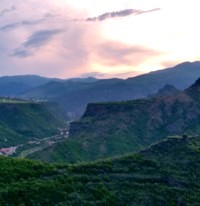Lake Sevan
The following morning, after an excellent breakfast at the Best Western, it was a short drive to Lake Sevan and the Sevanavank Monastery.
Our local guide told us that it was the biggest lake in the world, according to some narrow classification: was it elevation or volume? This engendered a discussion among the fellow travellers, who we discovered had each been to many other countries and locations around the world before thinking of travelling to Armenia as it's not usually at the top of most tourist's 'bucket list'.
Among the group were those, like us, who'd been to Lake Titicaca:
One of my photographs taken on Lake Titicaca (See more...)
Surface elevation: just over eight kilometres above sea level
Surface area: over eight thousand square kilometres
Volume: more than 800 cubic kilometres
Others had been to Lake Baikal in Siberia the largest exposed freshwater lake on the planet, with a volume of 24,000 cubic kilometres and a surface area of over 31 thousand square kilometres. But it's less than half a kilometre above sea level, so it's not an alpine lake.
Lake Sevan is definitely an alpine lake, with an elevation of 1.9 kilometres. Yet with a water volume of 33 cubic kilometres and a surface area of just over one thousand square kilometres it's dwarfed by Titicaca.
Nevertheless our guide still has grounds for pride. Lake Sevan is among the top ten alpine lakes in the world and it's unquestionably the largest freshwater alpine lake in the previous Soviet Union. And surprisingly we were not yet monasteried-out, so the Sevanavank Monastery added charmingly to the picturesque quality of the lake views.
Lake Sevan - unquestionably the highest freshwater lake in the Caucasus
and the Sevanavank Monastery
Although Lake Sevan never held as much water as its big brother on the border of Bolivia and Peru, it was once much larger than it is now.
At the end of the last glaciation the lake filled its entire basin an area of over five thousand square kilometres. But as the ice melt ended it shrank under natural climate change to about 1,416 square kilometres in 1936.
That's when man intervened to accelerate this shrinkage. Under Stalin's industrialisation, like the Aryl Sea in Uzbekistan, the lake was tapped, via a tunnel, for hydroelectricity and irrigation and the level fell by nearly 20 metres in a couple of decades. This was causing very obvious environmental damage, devastating communities along the lake shore. So representations were made to Khrushchev, who was inclined to reverse anything Stalin had done. So in 1964 the construction of two new tunnels was begun to divert the waters of the Arpa and Vorotan rivers to Lake Sevan.
The Arpa tunnel was completed in 1981 but the second was delayed by damage due to the devastating Armenian earthquake that struck in December 1988; the collapse of the Soviet Union; and war with Azerbaijan. It was finally completed in 2004 and since that time Lake Sevan has been rising steadily. But it still has some way to go before making good Stalin's depreciations.
Our local guide had an amusing story about how Nikita Khrushchev, a gullible Russian, was tricked into authorising the remediation tunnels by a wily Armenian (popular leader Anton Kochinyan). It was he who also allegedly tricked Leonid Brezhnev*, another gullible Russian, into authorising the Yerevan Metro.
Nikita Sergeyevich Khrushchev, who was Russia's mercurial 'Trump like' leader, when I started to take an interest in High School, often gets bad press. As I was told by the guide at Lenin's Tomb, in Red Square in Moscow, unlike other Russian Premiers, Nikita is not buried here because he was mad.
| The lake scam story - you can also find a version on-line: The Armenian leader, concerned about the lake level falling, first takes Nikita Sergeyevich to the famous Yerevan Brandy Factory then invites him out on the lake, offering a delicious local meal of the threatened local trout. "But how do I know the fish is local - from this lake," asks Nikita. "Give me a fishing rod and I will see for myself," he declares. The apparently prescient Armenian, having anticipated Nikita's scepticism, has a rod to hand and a diver waiting beneath the boat with a couple of prime trout in a bag. Naturally they are excellent eating and after a couple of vodkas to top up the brandy, Nikita Sergeyevich slams his shoe on the desk (my elaboration - See more...), then submits to the Armenian and signs on the dotted line. *The Metro approval came in the 70's, after Khrushchev - in the time of Brezhnev. It was initially approved as a light rail (tramway) because Yerevan was too small for a Metro. Yet local administrators did indeed take advantage of the approval to build the tunnels to accommodate a wide-gauge Metro. The Stations too are typically decorative. But it's small and is not as deep as other Soviet-era Metros like those in Baku and Tashkent, with three of the ten stations above ground. |
Fortunately for Armenia, the trout were thus saved from extinction, because they subsequently provided a major food source for the Armenian people during the post-Soviet collapse.
The fish of Lake Severn provided a major staple for the Armenian people during the post-Soviet famine
they remain an important resource today
There are more images in the Armenia Album See more...

